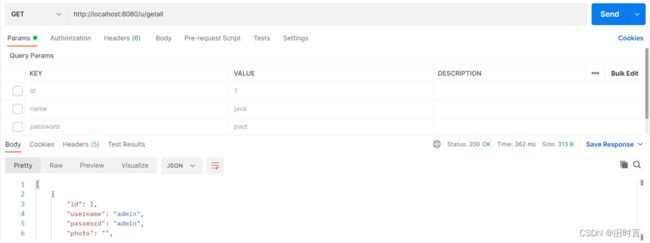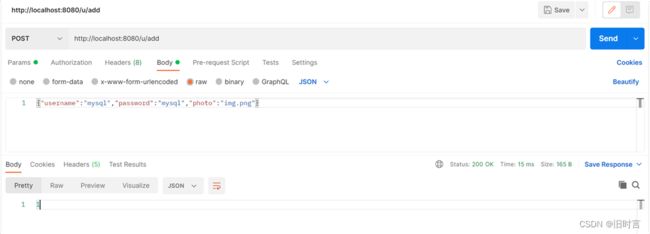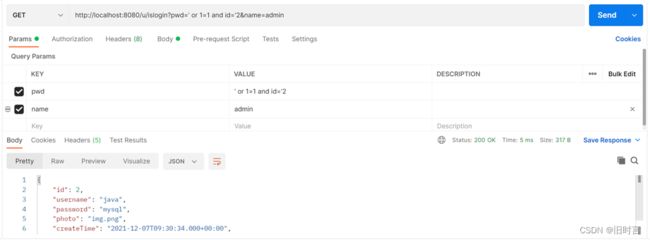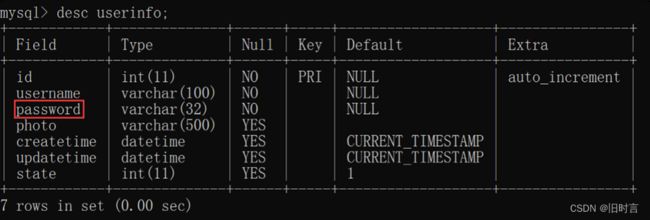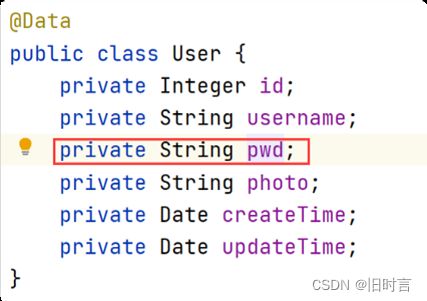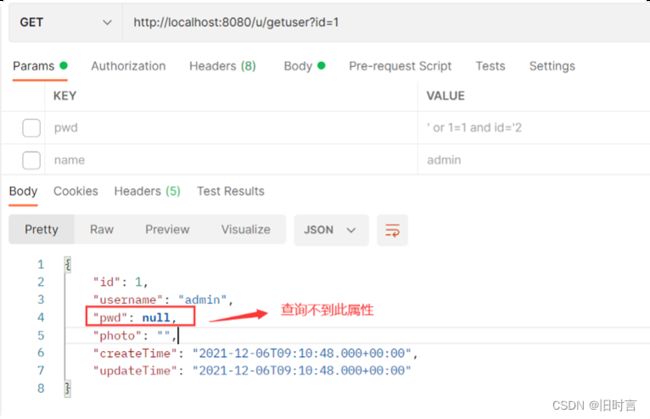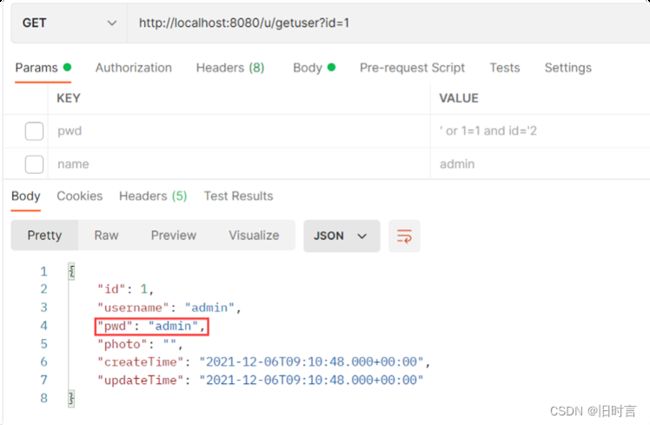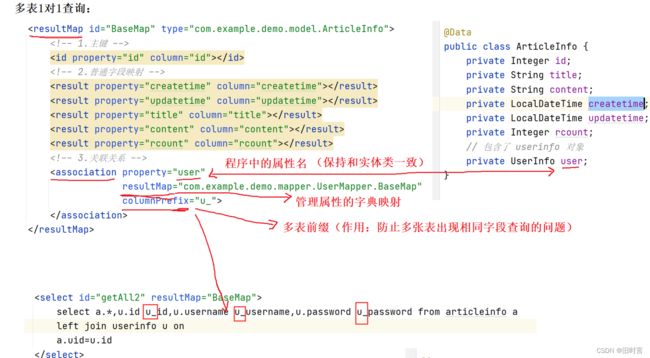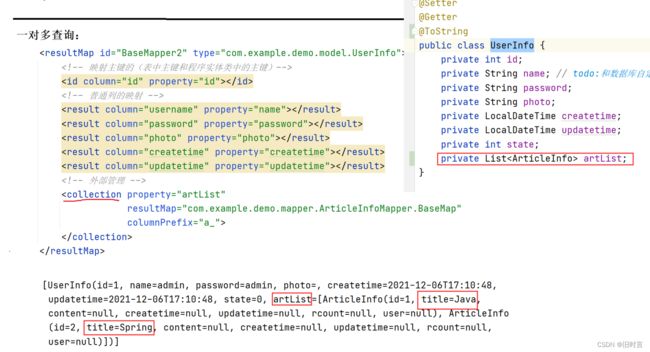MyBatis查询数据库
1.MyBatis 是什么?
MyBatis是一款优秀的持久层框架,它支持自定义SQL、存储过程以及高级映射。MyBatis去除了几乎所有的JDBC代码以及设置参数和获取结果集的工作。MyBatis可以通过简单的XML_或注解来配置和映射原始类型、接口和Java POJO (Plain Old Java Objects,普通老式Java对象)为数据库中的记录。
简单来说MyBatis是更简单完成程序和数据库交互的工具,也就是更简单的操作和读取数据库工具。
Mybatis官网:https://mybatis.org/mybatis-3/zh/index.html
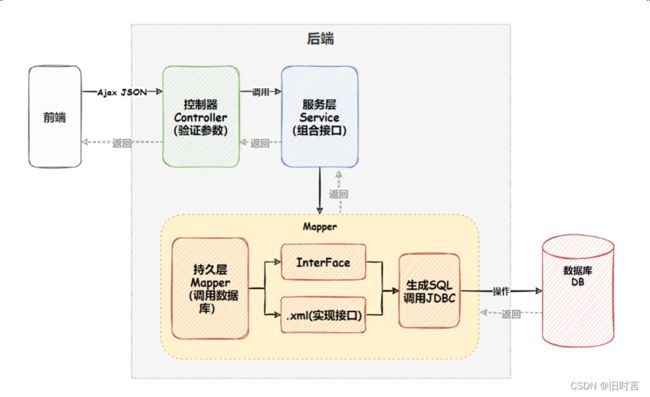
MyBatis也是一个ORM框架,ORM (Object Relational Mapping) ,即对象关系映射。在面向对象编程语言中,将关系型数据库中的数据与对象建立起映射关系,进而自动的完成数据与对象的互相转换:
- 将输入数据(即传入对象)+SQL映射成原生SQL
- 将结果集映射为返回对象,即输出对象
ORM把数据库映射为对象︰
- 数据库表(table) -->类(class)
- 记录(record,行数据)–>对象 (object)
- 字段(field) -->对象的属性(attribute)
一般的ORM框架,会将数据库模型的每张表都映射为一个Java类。
也就是说使用MyBatis可以像操作对象一样来操作数据库中的表,可以实现对象和数据库表之的转换,接下来我们来看MyBatis 的使用吧。
1.1 创建数据库和表
接下来我们要实现的功能是∶使用MyBatis 的方式来读取用户表中的所有用户,我们使用个人博客的数据库和数据包.具体SQL如下。
-- 创建数据库
drop database if exists mycnblog;
create database mycnblog DEFAULT CHARACTER SET utf8;
-- 使⽤数据数据
use mycnblog;
-- 创建表[⽤户表]
drop table if exists userinfo;
create table userinfo(
id int primary key auto_increment,
username varchar(100) not null,
password varchar(32) not null,
photo varchar(500) default '',
createtime datetime default now(),
updatetime datetime default now(),
`stateìnt default 1
);
-- 创建⽂章表
drop table if exists articleinfo;
create table articleinfo(
id int primary key auto_increment,
title varchar(100) not null,
content text not null,
createtime datetime default now(),
updatetime datetime default now(),
uid int not null,
rcount int not null default 1,
`stateìnt default 1
);
-- 创建视频表
drop table if exists videoinfo;
create table videoinfo(
vid int primary key,
`title` varchar(250),
ùrl` varchar(1000),
createtime datetime default now(),
updatetime datetime default now(),
uid int
);
-- 添加⼀个⽤户信息
INSERT INTO `mycnblog`.ùserinfo` (ìd`, ùsername`, `password`, `photo`,
`createtime`, ùpdatetime`, `state`) VALUES
(1, 'admin', 'admin', '', '2021-12-06 17:10:48', '2021-12-06 17:10:48',
1);
-- ⽂章添加测试数据
insert into articleinfo(title,content,uid)
values('Java','Java正⽂',1);
-- 添加视频
insert into videoinfo(vid,title,url,uid) values(1,'java
title','http://www.baidu.com',1);
1.2 配置连接字符串和MyBatis
此步骤需要进行两项设置,数据库连接字符串设置和MyBatis的XML文件配置。
配置连接字符串
如果是 application.yml 添加如下内容:
# 数据库连接配置
spring:
datasource:
url: jdbc:mysql://localhost:3306/mycnblog?
characterEncoding=utf8&useSSL=false
username: root
password: 940194
driver-class-name: com.mysql.cj.jdbc.Driver
注意事项:
如果使用 MySQL 是 5.x 之前的使用的是“com.mysql.jdbc.Driver”,如果是⼤于 5.x 使用的是“com.mysql.cj.jdbc.Driver”。
配置 MyBatis 中的 XML 路径
MyBatis 的 XML 中保存是查询数据库的具体操作 SQL,配置如下:
# 配置 mybatis xml 的⽂件路径,在 resources/mapper 创建所有表的 xml ⽂件
mybatis:
mapper-locations: classpath:mapper/**Mapper.xml
1.3 添加业务代码
下面按照后端开发的工程思路,也就是下面的流程来实现MyBatis查询所有用户的功能:

1.3.1 添加实体类
先添加用户的实体类:
import lombok.Data;
import java.util.Date;
@Data
public class User {
private Integer id;
private String username;
private String password;
private String photo;
private Date createTime;
private Date updateTime;
}
1.3.2 添加mapper接口
数据持久层的接口定义:
import org.apache.ibatis.annotations.Mapper;
import java.util.List;
@Mapper
public interface UserMapper {
public List<User> getAll();
}
1.3.3 添加 UserMapper.xml
数据持久成的实现,mybatis 的固定 xml 格式:
<?xml version="1.0" encoding="UTF-8"?>
<!DOCTYPE mapper PUBLIC "-//mybatis.org//DTD Mapper 3.0//EN"
"http://mybatis.org/dtd/mybatis-3-mapper.dtd">
<mapper namespace="com.example.demo.mapper.UserMapper">
</mapper>
UserMapper.xml 查询所有用户的具体实现 SQL:
DOCTYPE mapper PUBLIC "-//mybatis.org//DTD Mapper 3.0//EN"
"http://mybatis.org/dtd/mybatis-3-mapper.dtd">
<mapper namespace="com.example.demo.mapper.UserMapper">
<select id="getAll" resultType="com.example.demo.model.User">
select * from userinfo
select>
mapper>
以下是对以上标签的说明:
- 标签︰需要指定
namespace属性,表示命名空间,值为mapper接口的全限定名,包括全包名.类名。 - 查询标签:是用来执行数据库的查询操作的:
- id:是和Interface (接口)中定义的方法名称一样的,表示对接口的具体实现方法。
- resultType:是返回的数据类型,也就是开头我们定义的实体类。
1.3.4 添加服务层
服务层实现代码如下:
import org.springframework.stereotype.Service;
import javax.annotation.Resource;
import java.util.List;
@Service
public class UserService {
@Resource
private UserMapper userMapper;
public List<User> getAll() {
return userMapper.getAll();
}
}
1.4.5 添加控制层
控制器层的实现代码如下:
import org.springframework.web.bind.annotation.RequestMapping;
import org.springframework.web.bind.annotation.RestController;
import javax.annotation.Resource;
import java.util.List;
@RestController
@RequestMapping("/u")
public class UserController {
@Resource
private UserService userService;
@RequestMapping("/getall")
public List<User> getAll(){
return userService.getAll();
}
}
以上代码写完,整个 MyBatis 的查询功能就实现完了,接下来使用 postman 来测试⼀下。
1.4.6 使用 postman 测试
2. 增、删、改操作
接下来,我们来实现一下用户的增加、删除和修改的操作,对应使用MyBatis 的标签如下:
- insert标签:插入语句
- update标签:修改语句
- delete标签︰删除语句
注:开启Mybatis 执行日志
#开启Mybaits sql打印
mybaits.configuration.log-impl=org.apache.ibatis.logging.stdout.std0utImpl
2.1 增加用户操作
controller 实现代码︰
@RequestMapping(value = "/add",method = RequestMethod.POST)
public Integer add(@RequestBody User user){
return userService.getAdd(user);
}
mapper interface:
Integer add(User user);
mapper.xml
<insert id="add">
insert into userinfo(username,password,photo,state)
values(#{username},#{password},#{photo},1)
insert>
Postman 添加访问:
默认情况下返回的是受影响的行数,如上图所示,用到的json 数据如下:
{"username":"mysql","password":"mysql","photo":"img.png"}
特殊的添加:返回自增id
默认情况下返回的是受影响的行号,如果想要返回自增id,具体实现如下。
controller 实现代码:
@RequestMapping(value = "/add2", method = RequestMethod.POST)
public Integer add2(@RequestBody User user) {
userService.getAdd2(user);
return user.getId();
}
mapper 接口:
@Mapper
public interface UserMapper {
// 添加,返回⾃增id
void add2(User user);
}
mapper.xml 实现如下:
<insert id="add2" useGeneratedKeys="true" keyProperty="id">
insert into userinfo(username,password,photo,state)
values(#{username},#{password},#{photo},1)
insert>
- useGeneratedKeys:这会令MyBatis使用JDBC的getGeneratedKeys方法来取出由数据库内部生成的主键(比如︰像MySQL和SQLServer这样的关系型数据库管理系统的自动递增字段),默认值: false。
- keyColumn:设置生成键值在表中的列名,在某些数据库(像PostgreSQL)中,当主键列不是表中的第一列的时候,是必须设置的。如果生成列不止一个,可以用逗号分隔多个属性名称。
- keyProperty:指定能够唯一识别对象的属性,MyBatis 会使用getGeneratedKeys的返回值或insert语句的selectKey子元素设置它的值,默认值∶未设置(unset)。如果生成列不止一个,可以用逗号分隔多个属性名称。
2.2 修改用户操作
controller:
@RequestMapping("/update")
public Integer update(Integer id, String name) {
return userService.update(id, name);
}
mapper.xml 实现代码:
<update id="update">
update userinfo set username=#{name} where id=#{id}
update>
2.3 删除用户操作
<delete id="delById" parameterType="java.lang.Integer">
delete from userinfo where id=#{id}
delete>
3. 查询操作
3.1 单表查询
下面我们来实现⼀下根据用户 id 查询用户信息的功能。
Controller 实现代码如下:
@RequestMapping("/getuser")
public User getUserById(Integer id) {
return userService.getUserById(id);
}
Mapper.xml 实现代码如下:
<select id="getUserById" resultType="com.example.demo.model.User">
select * from userinfo where id=#{id}
select>
3.1.1 参数占位符#{}和${}
- #{}: 预编译处理。
- ${}: 字符直接替换。
预编译处理: 在处理#{}时,会将SQL中的#{}替换为?号(例如: “?”),替换后会加上引号,使用PreparedStatement的set方法来赋值。
直接替换∶在处理 ${} 时,就是把 ${}直接替换成变量的值。
3.1.2 ${} 优点
<select id="getAllBySort" parameterType="java.lang.String"
resultType="com.example.demo.model.User">
select * from userinfo order by id ${sort}
select>
使用${sort}可以实现排序查询,而使用#{sort}就不能实现排序查询了,因为当使用#{sort}查询时如果传递的值为 String 则会加单引号,就会导致sql错误。
3.1.3 SQL 注入问题
<select id="isLogin" resultType="com.example.demo.model.User">
select * from userinfo where username='${name}' and password='${pwd}'
select>
结论:
用于查询的字段,尽量使用#{}预查询的方式。#{}可以防止SQL注入,${}不能防止SQL注入。
3.1.4 like查询
like使用#{}报错
<select id="findUserByName2" resultType="com.example.demo.model.User">
select * from userinfo where username like '%#{username}%';
select>
相当于: select * from userinfo where username like ‘%‘username’%’;
这个是不能直接使用${},可以考虑使用mysql的内置函数concat()来处理,实现代码如下︰
<select id="findUserByName3" resultType="com.example.demo.model.User">
select * from userinfo where username like concat('%',#{username},'%');
select>
3.2 多表查询
如果是增、删、改返回影响的行数,那么在mapper.xml 中是可以不设置返回的类型的,如下图所示∶

然而即使是最简单查询用户的名称也要设置返回的类型,否则会出现如下错误。
查询不设置返回类型的错误示例演示
controller代码:
@RequestMapping("/getname")
public String getNameById(Integer id) {
return userService.getNameById(id);
}
mapper.xml 实现代码:
<select id="getNameById">
select username from userinfo where id=#{id}
select>
访问接口执行结果如下:
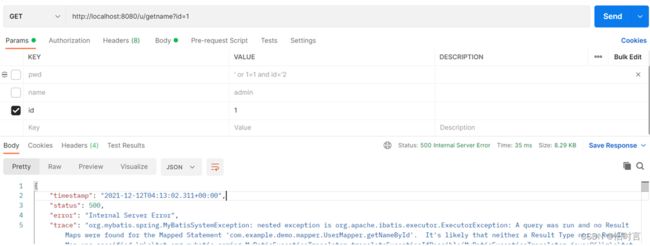
显示运行了一个查询但没有找到结果映射,也就是说对于select查询标签来说至少需要两个属性.
- id属性: 用于标识实现接口中的那个方法;
- 结果映射属性: 结果映射有两种实现标签: resultMap和resultType。
3.2.1 返回类型:resultType
绝大数查询场景可以使用resultType进行返回,如下代码所示:
<select id="getNameById" resultType="java.lang.String">
select username from userinfo where id=#{id}
select>
<select id="login2" resultType="com.example.demo.model.UserInfo">
select * from userinfo
<where>
<if test="username!=null">
username=#{username}
if>
<if test="password!=null">
and password=#{password}
if>
where>
select>
它的优点是使用方便,直接定义到某个实体类即可。
3.2.2 返回字典映射:resultMap
resultMap 使用场景:
- 字段名称和程序中的属性名不同的情况,可使用resultMap 配置映射;
- 一对一和一对多关系可以使用resultMap映射并查询数据。
字段名和属性名不同的情况
mapper.xml 代码如下:
<select id="getUserById" resultType="com.example.demo.model.User">
select * from userinfo where id=#{id}
select>
这个时候就可以使用 resultMap 了,resultMap 的使用如下:
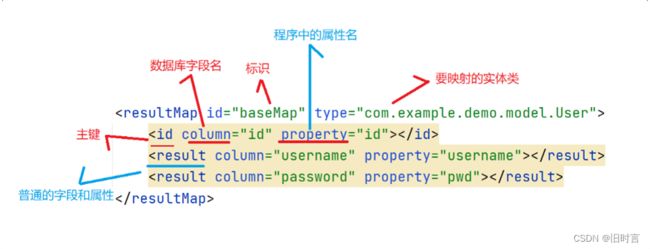
mapper.xml
<resultMap id="BaseMap" type="com.example.demo.model.User">
<id column="id" property="id">id>
<result column="username" property="username">result>
<result column="password" property="pwd">result>
resultMap>
<select id="getUserById"
resultMap="com.example.demo.mapper.UserMapper.BaseMap">
select * from userinfo where id=#{id}
select>
3.2.3 多表查询
在多表查询时,如果使用resultType标签,在一个类中包含了另一个对象是查询不出来被包含的对象的,比如以下实体类:
@Data
public class ArticleInfo {
private Integer id;
private String title;
private String content;
private LocalDateTime createtime;
private LocalDateTime updatetime;
private Integer rcount;
// 包含了 userinfo 对象
private UserInfo user;
}
<select id="getAll" resultType="com.example.demo.model.ArticleInfo">
select a.*,u.* from articleinfo a left join userinfo u on a.uid=u.id
select>
程序的执行结果如下图所示:

此时我们就需要使用特殊手段来实现联表查询了。
3.2.3.1 一对一: 一篇文章对应一个作者
一对一映射要使用association标签,具体实现如下(一篇文章只对应一个作者)︰
<resultMap id="BaseMap" type="com.example.demo.model.ArticleInfo">
<id property="id" column="id">id>
<result property="title" column="title">result>
<result property="content" column="content">result>
<result property="createtime" column="createtime">result>
<result property="updatetime" column="updatetime">result>
<result property="uid" column="uid">result>
<result property="rcount" column="rcount">result>
<result property="state" column="state">result>
<association property="user"
resultMap="com.example.demo.mapper.UserMapper.BaseMap"
columnPrefix="u_">
association>
resultMap>
<select id="getAll" resultMap="BaseMap">
select a.*,u.username u_username from articleinfo a
left join userinfo u on a.uid=u.id
select>
以上使用association标签,表示一对一的结果映射:
property属性:指定Article中对应的属性,即用户。resultMap属性∶指定关联的结果集映射,将基于该映射配置来组织用户数据。columnPrefix属性:绑定一对一对象时,是通过
columnPrefix+association.resultMap.column来映射结果集字段。
association.resultMap.column是指标签中resultMap属性,对应的结果集映射中,column字段。
注意事项: columnPrefix 不能省略
columnPrefix 如果省略,并且恰好两个表中如果有相同的字段,那么就会导致查询出错,示例如下:
ArticleInfo.java
@Data
public class ArticleInfo {
private Integer id;
private String title;
private String content;
private LocalDateTime createtime;
private LocalDateTime updatetime;
private Integer rcount;
// 包含了 userinfo 对象
private UserInfo user;
}
UserInfo.java
@Data
public class UserInfo {
private int id;
private String name; // todo:和数据库自定不一致,username
private String password;
private String photo;
private LocalDateTime createtime;
private LocalDateTime updatetime;
private int state;
private List<ArticleInfo> artList;
}
ArticleInfoMapper.xml
DOCTYPE mapper PUBLIC "-//mybatis.org//DTD Mapper 3.0//EN" "http://mybatis.org/dtd/mybatis-3-mapper.dtd">
<mapper namespace="com.example.demo.mapper.ArticleInfoMapper">
<resultMap id="BaseMap" type="com.example.demo.model.ArticleInfo">
<id property="id" column="id">id>
<result property="createtime" column="createtime">result>
<result property="updatetime" column="updatetime">result>
<result property="title" column="title">result>
<result property="content" column="content">result>
<result property="rcount" column="rcount">result>
<association property="user"
resultMap="com.example.demo.mapper.UserMapper.BaseMap"
columnPrefix="u_">
association>
resultMap>
<select id="getAll" resultType="com.example.demo.model.ArticleInfo">
select a.*,u.*
from articleinfo a left join userinfo u
on a.uid=u.id
select>
<select id="getAll2" resultMap="BaseMap">
select a.*,u.id u_id,u.username u_username,u.password u_password
from articleinfo a left join userinfo u on
a.uid=u.id
select>
<select id="getAll3" resultType="com.example.demo.model.ArticleInfo">select>
mapper>
UserMapper.xml
DOCTYPE mapper PUBLIC "-//mybatis.org//DTD Mapper 3.0//EN" "http://mybatis.org/dtd/mybatis-3-mapper.dtd">
<mapper namespace="com.example.demo.mapper.UserMapper">
<resultMap id="BaseMap" type="com.example.demo.model.UserInfo">
<id column="id" property="id">id>
<result column="username" property="name">result>
<result column="password" property="password">result>
<result column="photo" property="photo">result>
<result column="createtime" property="createtime">result>
<result column="updatetime" property="updatetime">result>
resultMap>
<resultMap id="BaseMapper2" type="com.example.demo.model.UserInfo">
<id column="id" property="id">id>
<result column="username" property="name">result>
<result column="password" property="password">result>
<result column="photo" property="photo">result>
<result column="createtime" property="createtime">result>
<result column="updatetime" property="updatetime">result>
<collection property="artList"
resultMap="com.example.demo.mapper.ArticleInfoMapper.BaseMap"
columnPrefix="a_">
collection>
resultMap>
<select id="getAll3" resultMap="BaseMapper2">
select u.*,a.id a_id,a.title a_title
from userinfo u left join articleinfo a
on u.id=a.uid
select>
mapper>
3.2.3.2 一对多: 一个作者对应多篇文章
一对多需要使用collection标签,用法和association相同,如下所示:
<resultMap id="BaseMap" type="com.example.demo.model.User">
<id column="id" property="id" />
<result column="username" property="username">result>
<result column="password" property="password">result>
<result column="photo" property="photo">result>
<collection property="alist"
resultMap="com.example.demo.mapper.ArticleInfoMapper.BaseMap"
columnPrefix="a_">
collection>
resultMap>
<select id="getUserById" resultMap="BaseMap">
select u.*,a.title a_title
from userinfo u left join articleinfo a
on u.id=a.uid where u.id=#{id}
select>
4. 复杂情况:动态SQL使用
动态sql是Mybatis的强大特性之一,能够完成不同条件下不同的sql拼接。
可以参考官方文档:Mybatis动态sql
4.1 标签
在注册用户的时候,可能会有这样⼀个问题,如下图所示:
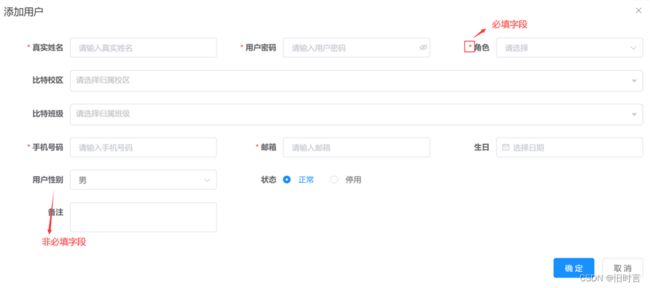
注册分为两种字段∶必填字段和非必填字段,那如果在添加用户的时候有不确定的字段传入,程序应该如何实现呢?
这个时候就需要使用动态标签
<insert id="insert" parameterType="org.example.model.User"
useGeneratedKeys="true" keyProperty="id">
insert into user(
username,
password,
nickname,
<if test="sex != null">
sex,
if>
birthday,
head
) values (
#{username},
#{password},
#{nickname},
<if test="sex != null">
#{sex},
if>
#{birthday},
#{head}
)
insert>
注意test 中的sex,是传入对象中的属性,不是数据库字段。
4.2 标签 -》增(insert)
之前的插入用户功能,只是有一个sex字段可能是选填项,如果有多个字段,一般考虑使用
- prefix: 表示整个语句块,以prefix的值作为前缀
- suffix: 表示整个语句块,以suffix的值作为后缀
- prefixOverrides: 表示整个语句块要去除掉的前缀
- suffixOverrides: 表示整个语句块要去除掉的后缀
调整UserMapper.xml的插入语句为︰
<insert id="insert" parameterType="org.example.model.User"
useGeneratedKeys="true" keyProperty="id">
insert into user
<trim prefix="(" suffix=")" suffixOverrides=",">
<if test="username != null">
username,
if>
<if test="password != null">
password,
if>
<if test="nickname != null">
nickname,
if>
<if test="sex != null">
sex,
if>
<if test="birthday != null">
birthday,
if>
<if test="head != null">
head,
if>
<if test="createTime != null">
create_time,
if>
trim>
<trim prefix="values (" suffix=")" suffixOverrides=",">
<if test="username != null">
#{username},
if>
<if test="password != null">
#{password},
if>
<if test="nickname != null">
#{nickname},
if>
<if test="sex != null">
#{sex},
if>
<if test="birthday != null">
#{birthday},
if>
<if test="head != null">
#{head},
if>
<if test="createTime != null">
#{createTime},
if>
trim>
insert>
在以上sql动态解析时,会将第一个
- 基于
prefix配置,开始部分加上( - 基于
suffix配置,结束部分加上) - 多个
组织的语句都以,结尾 ,在最后拼接好的字符串还会以,结尾,会基于suffixOverrides配置去掉最后一个, - 注意
4.5 标签 -》删(delete)
对集合进行遍历时可以使用该标签。
- collection:绑定方法参数中的集合,如List,Set,Map或数组对象
- item:遍历时的每一个对象
- open:语句块开头的字符串
- close:语句块结束的字符串
- separator:每次遍历之间间隔的字符串
示例∶根据多个文章id来删除文章数据。ArticleMapper中新增接口方法:
int deleteByIds(List<Integer> ids);
ArticleMapper.xml 中新增删除 sql:
<delete id="deleteByIds">
delete from article
where id in
<foreach collection="list" item="item" open="(" close=")"
separator=",">
#{item}
foreach>
delete>
4.4 标签 -》改(update)
根据传⼊的用户对象属性来更新用户数据,可以使用
UserMapper 接口中修改用户方法:根据传⼊的用户 id 属性,修改其他不为 null 的属性:
int updateById(User user);
UserMapper.xml 中添加更新用户 sql:
<update id="updateById" parameterType="org.example.model.User">
update user
<set>
<if test="username != null">
username=#{username},
if>
<if test="password != null">
password=#{password},
if>
<if test="nickname != null">
nickname=#{nickname},
if>
<if test="sex != null">
sex=#{sex},
if>
<if test="birthday != null">
birthday=#{birthday},
if>
<if test="head != null">
head=#{head},
if>
<if test="createTime != null">
create_time=#{createTime},
if>
set>
where id=#{id}
update>
以上
4.3 标签 -查(select)
传入的用户对象,根据属性做where条件查询,用户对象中属性不为null的,都为查询条件。如user.username为"a",则查询条件为where username=“a” :
UserMapper接口中新增条件查询方法:
List<User> selectByCondition(User user);
UserMapper.xml 中新增条件查询 sql:
<select id="selectByCondition" parameterType="org.example.model.User"
resultMap="BaseResultMap">
select id, username, password, nickname, sex, birthday, head,
create_time
from user
<where>
<if test="username != null">
and username=#{username}
if>
<if test="password != null">
and password=#{password}
if>
<if test="nickname != null">
and nickname=#{nickname}
if>
<if test="sex != null">
and sex=#{sex}
if>
<if test="birthday != null">
and birthday=#{birthday}
if>
<if test="head != null">
and head=#{head}
if>
<if test="createTime != null">
and create_time=#{createTime}
if>
where>
select>
以上

